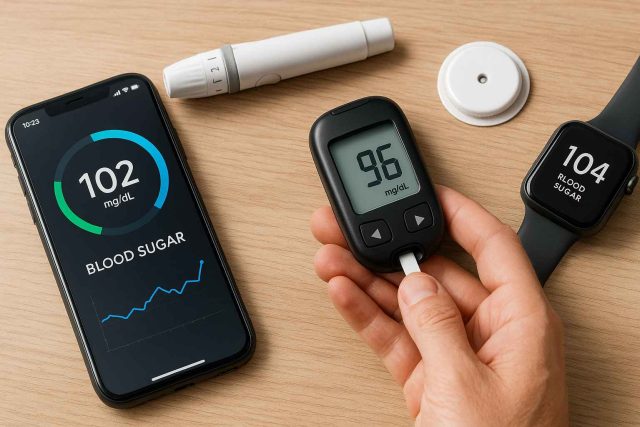Effective blood sugar monitoring is the backbone of modern diabetes management. In 2025, clinicians and healthcare professionals have access to more precise, convenient, and connected tools than ever before. These innovations are not only enhancing glycemic control but also improving patient engagement and outcomes.
With technology rapidly advancing, how do you decide which tools provide the most value in clinical practice? From next-generation CGMs to AI-powered apps, this article explores the leading blood sugar monitoring solutions shaping diabetes care in 2025.
Table of Contents
- Continuous Glucose Monitors: The New Standard
- Smart Meters and At-Home Testing Kits
- Mobile Apps, Data Platforms, and EHR Integration
- Clinical Considerations for Choosing the Right Tools
- Conclusion and FAQs
Continuous Glucose Monitors: The New Standard
In recent years, continuous glucose monitors (CGMs) have transformed blood sugar monitoring by offering real-time data with minimal patient effort. In 2025, CGMs are widely adopted in both Type 1 and Type 2 diabetes management.
Leading CGM systems like Dexcom G7, Abbott FreeStyle Libre 3, and Medtronic Guardian 4 now offer smaller sensors, faster warm-up times, and direct-to-smartphone connectivity. Patients can view trends, get alerts for high or low glucose, and share data with providers seamlessly.
The latest models boast predictive algorithms that anticipate fluctuations and reduce glycemic variability. Dexcom’s Clarity and LibreView platforms enable remote monitoring, which helps reduce office visits while improving clinical oversight.
Importantly, CGM use has been linked to improved time-in-range and reduced A1C levels in both adult and pediatric populations. Studies published in Diabetes Technology & Therapeutics emphasize their role in reducing hypoglycemia, especially in older adults and those with impaired awareness.
Smart Meters and At-Home Testing Kits
Despite CGM popularity, fingerstick meters remain essential, particularly for patients without CGM coverage or those using hybrid monitoring. Fortunately, traditional blood glucose meters have become more sophisticated.
Smart meters like OneTouch Verio Reflect and Contour Next One now sync with mobile apps to log readings automatically. These devices provide color-coded trend feedback, allow for manual input of insulin and meal data, and help patients recognize patterns.
Some meters also support speech output for visually impaired users and Bluetooth integration with third-party diabetes apps. Additionally, at-home A1C test kits—such as those from A1CNow+—allow patients to monitor long-term control between lab visits.
Although less advanced than CGMs, smart meters play a vital role in blood sugar monitoring by offering flexibility and backup data. They’re particularly useful in hospital discharge planning, elderly care, and settings with limited digital literacy.
Mobile Apps, Data Platforms, and EHR Integration
The expansion of digital health tools has revolutionized how clinicians and patients interact with blood sugar data. In 2025, most blood sugar monitoring devices integrate with mobile apps that track glucose, insulin doses, diet, and physical activity.
Top-rated platforms like Glooko, Tidepool, and MySugr provide consolidated dashboards that support decision-making and improve self-management. These apps now offer advanced features, including:
- Pattern recognition with AI insights
- Customizable reminders and nudges
- Virtual coaching and goal setting
Integration with electronic health records (EHRs) allows clinicians to import glucose data directly into patient charts. Platforms such as Epic and Cerner now offer seamless CGM and meter integration, reducing administrative burden and allowing for quicker clinical decisions.
For peer support and patient-facing forums, refer patients to Health.HealingWell.com. These resources enhance education and community engagement between visits.
Clinical Considerations for Choosing the Right Tools
Selecting the best blood sugar monitoring tools for each patient involves weighing multiple factors:
1. Diabetes Type and Complexity: Type 1 patients may benefit more from CGMs with alerts and trend insights. Meanwhile, patients with Type 2 diabetes on oral medications may prefer simplified meters or intermittent CGM.
2. Insurance Coverage and Affordability: Although devices like Dexcom and Libre are increasingly covered, disparities remain. Cost discussions and prior authorization support are essential.
3. Digital Literacy: Not every patient is comfortable with smartphones and apps. Simple, intuitive devices with minimal setup should be prioritized in such cases.
4. Comorbid Conditions: Patients with vision impairment, arthritis, or cognitive decline may require meters with large displays, fewer buttons, or voice-guided prompts.
5. Clinical Goals: Improving time-in-range, reducing hypoglycemia, and increasing treatment adherence are central. Tools that offer trend analysis and actionable insights support these outcomes best.
Regular technology reviews during clinic visits help ensure continued device alignment with the patient’s needs. Providers can also use resources at Diabetes in Control for comparative charts and device updates.
Conclusion and Key Takeaways
Blood sugar monitoring in 2025 is smarter, more connected, and more personalized than ever before. Whether using a CGM with real-time data, a smart meter with app support, or integrated platforms that sync with the EHR, healthcare providers have the opportunity to improve diabetes management across all care settings.
With thoughtful tool selection, ongoing education, and patient-specific plans, clinicians can help individuals with diabetes stay informed, engaged, and on track for healthier outcomes.
FAQs
What is the best CGM for blood sugar monitoring in 2025?
Dexcom G7 and FreeStyle Libre 3 are leading choices due to accuracy, ease of use, and smartphone integration.
Are fingerstick meters still necessary if using a CGM?
Yes, they are useful for calibration, backup, and in patients who cannot afford continuous monitoring.
Can blood sugar monitoring data be shared with doctors remotely?
Absolutely. Platforms like Glooko and Dexcom Clarity allow real-time data sharing with healthcare providers.
Which app works best with multiple devices?
Tidepool and Glooko offer robust compatibility across CGMs, insulin pumps, and smart meters.
How often should blood sugar be monitored?
Monitoring frequency depends on the type of diabetes, treatment plan, and device used. CGMs provide near-continuous tracking, while meter users may test 2–7 times daily.
Disclaimer:
This content is not medical advice. For any health issues, always consult a healthcare professional. In an emergency, call 911 or your local emergency services.
